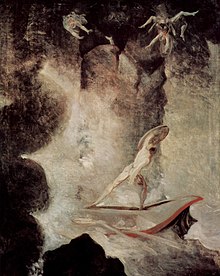Charybdis
In Greek mythology, Carybdis (in ancient Greek Χάρυβδις Chárybdis, 'sucker') is a horrible female sea monster, daughter of Poseidon and Gaea, who swallowed enormous amounts of water three times a day and returned as many times, thus taking the form of a whirlpool that devoured everything within its reach. This monster appears prominently in the Odyssey.
She lived with Scylla, another female sea monster, in a narrow sea passage. Both sides of the strait were within arrow range, so close that sailors trying to avoid Charybdis passed too close to Scylla, and vice versa. The expression "between Scylla and Charybdis" has come to mean being between two dangers so that moving away from one causes you to fall into the other.
The Argonauts were able to avoid both dangers thanks to the guidance of the Nereid Thetis, who followed the orders of Hera, protector of the hero company. Odysseus was not so lucky, but he followed the prudent advice of Circe: «It is better that you stick to the foot of the rock of Scylla and accelerate the ship as it passes. You'd better lose just six men at most than go down yourself with them all."
Traditionally, Charybdis' location in the Strait of Messina makes it associated with the eddy currents found in the area, but it is rarely dangerous. Recent research has re-examined the site and suggests that this association is erroneous, and that a more likely origin of the story could be found near Cape Skilla, northwestern Greece. Other researchers, however, maintain that it is a purely fabulous place that cannot be identified with any real setting.
Late authors imagined a non-monstrous origin for Charybdis. It is said that she was once a mortal woman whose gluttony was notorious, and that she dared to steal some of Heracles' oxen herd. An angry Zeus struck her with lightning and plunged her under the sea, and she has retained her characteristic voracity ever since. Others say she was originally a sea nymph who flooded the land to expand her father Poseidon's underwater kingdom, until her paternal uncle Zeus transformed her into a monster.
Contenido relacionado
Vucub Caquix
Aglaya
Urania
